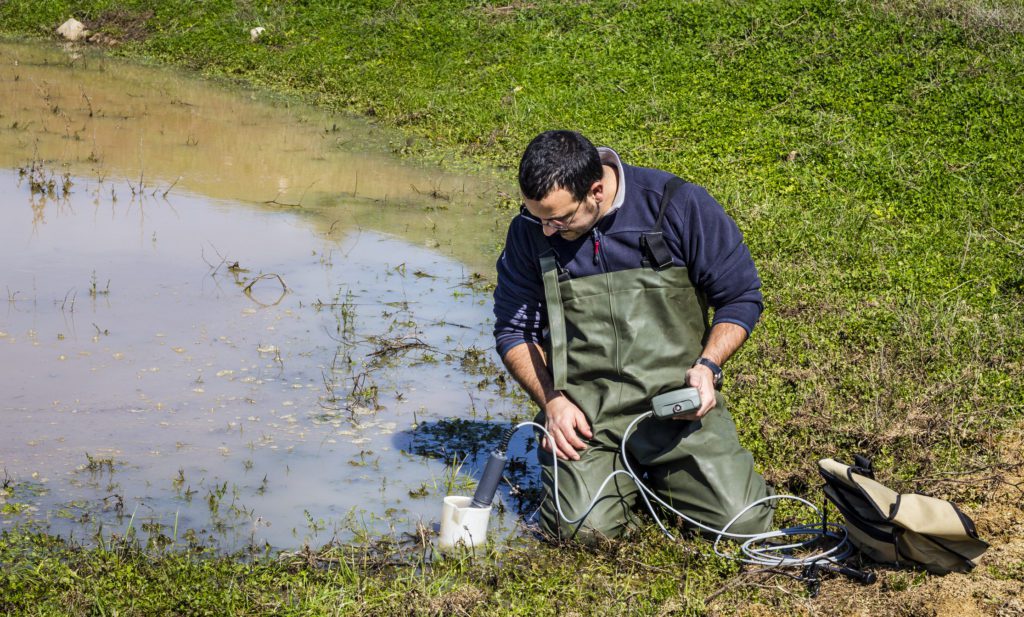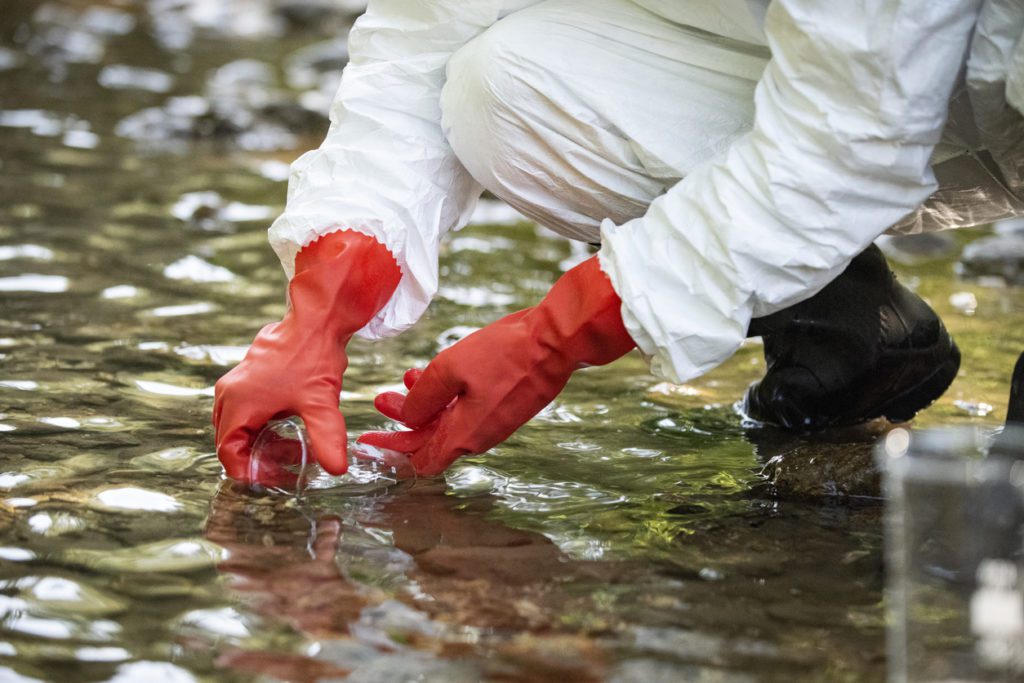Water analysis and monitoring is a specific programmed process of sampling, measuring, and recording various water characteristics and analytes. Data collected from water analysis monitoring can be used to signal environmental factors and control the various industries with the goal of conformity to specific objectives.
Environmental protection agency bodies across nations work with these industries to conduct continuous water monitoring with the aim to protect the environment and ensure the quality of drinking water, among other reasons. With this data collection, contaminated water sources can be effectively treated, to then be reintroduced responsibly.
Water analysis methods can be used to detect several substances in the sample, including dissolved solids and chemicals components affecting the pH levels.
As with all sampling and monitoring methods, some challenges need to be considered and addressed in order to adhere to water quality standards and regulations.
Water analysis and monitoring processes fall into four clear categories:
Water quality monitoring is a necessary and important part of environmental protection and compliance with drinking water standards. With continuous data collection, objective and effective decisions can be made to manage water quality today and in the future.

Similar to air quality control, monitoring water is essential for human health. Employing responsible resources will provide sufficient supply in years to come.
Continuous water quality monitoring with intelligent development also takes into account environmental components as part of a complex ecology. With this data, experts and industries can:
With appropriate management schemes in place, nations can combat climate change and promote sustainable methods for industries. In effect, this will secure cleaner and healthier marine ecosystems and environments.
A whole range of liquid stream sources is monitored across the globe by authorities and personnel within industries. The main areas for concern are potable water, palatable water, contaminated (polluted) water, and infected water.
These concerns can found across the following areas of water:
Approximately 68% of the water source provided to communities comes from surface water. This can either be permanent (in the form of lakes, lagoons, and rivers) or ephemeral water bodies that are seasonally present. Therefore, this water is not only needed to be potable for drinking purposes but also palatable for livestock and irrigation needs.
Groundwater is stored in and moves slowly through geologic formations of soil, sand and rocks. This is fundamental to the sustainability of the natural world and ecosystems.
Wastewater can refer to the runoff from stormwater and agricultural sources, as well as household kitchens, laundry, and of the like. Treatment of this water is necessary before recirculation into the cycle of the natural environment to maintain regulated standards.
Surface or groundwater abstracted for drinking water must meet rigorous chemical standards following treatment. The enforceable primary standards are in place as protection for human health.
Standards are ever-evolving in light of new scientific advances and knowledge about the health effects of chemical and biological constituents in drinking water.
Developments in microbial detection techniques have added new waterborne pathogens to the list of drinking water standards. Monitoring detection systems are in place at key points throughout the water distribution network. Efficient placement of such stations is necessary to allow individual sections to be monitored and managed accordingly.
Samples of water from the natural environment are taken by regulatory authorities. This is to ensure that the waters, ground and surface waters, are unpolluted.
If data shows pollution is present, continued monitoring will assess levels to show them not to be rising, or they should be falling in accordance with a remediation plan.
Natural environment water monitoring and control is important to protect the world’s oceans, aquatic life, and human populations.

Recent monitoring systems have allowed room for new projects to work with desalinating sea water as a solution for drought regions. This program not only working to stabilises sea levels and help the environment, but also provide a strong economy for the local communities nearby.
In industrial processes, the control of the quality of process water greatly affects the end product. Water is often used as a carrier of reagents and is subsequently a byproduct. Any loss must be continuously monitored to ensure the correct replacement rate. All parameters will relate specifically and uniquely to that particular process.
Produced water management and ensuring a standard of water quality is not only good health practice, but is also essential for consistent process in some instances.
For example, in oil and gas production, all produced water is treated at the surface to either be reintroduced back into the process or expelled to the environment. There are a number of potential threats that could have damaging effects if this water is not analysed and treated at several points of the process.
There are numerous analytes monitored across these various water bodies. If left untreated, water containing these chemicals or pollutants can have a detrimental impact on the nutrients and natural balance of the environment.
Analysis of wastewater is a necessity for industries to protect nutrient levels within the environment. Responsible management of effluents ensures sustainability across processes and industries.
The following are just some of the analytes monitored across various water bodies.
pH levels
The pH level is the measurement of hydrogen ions in water. Pure water is 7 while anything below this is considered acidic, and anything above is alkaline. Surface water pH levels range between 6.5 and 8.5, while groundwater levels tend to be between 6 and 8.5.
Dissolved oxygen
A depleted level of dissolved oxygen in the water results in marine life deaths, including fish and fauna.
Electrical conductivity
Analysis of water conductivity concludes whether dissolved solids, chemicals, and minerals are present. Higher concentrations of these analytes will lead to higher conductivity.
Alkali metals
Metal traces, such as magnesium, calcium, and sodium can increase the heat of water and hydrogen levels.
Toxic metals
Heavy metal pollutants such as aluminium, copper, and zinc typically come from a specific known source. Even the slightest trace can increase the toxicity of water sources if mismanaged.
Herbicides and pesticides
Commonly used in agricultural industries to maximise crop yields. Drainage, despite proper irrigation management efforts, can lead to pesticide runoff into waterways and freshwater supplies. This is where monitoring wells come into play.
Hydrocarbon oils
Water contaminated with hydrocarbons can be carcinogenic, neurotoxin, and mutagenic to flora and fauna in the natural environment. Hydrocarbon molecules can be free-floating, emulsified, dissolved, or adsorbed to suspended solids.
Nitrates
High levels of nitrates in water can lead to excessive growth of plants and algae, which then leads to unstable amounts of dissolved oxygen levels. Increased nitrate levels are an effect of improper waste management, overuse of chemical fertilisers, and unsuitable construction projects.
Solids
Solids in water can be any particles that measure greater than 2 microns in diameter. These can be anything from volatile organic compounds to suspended and dissolved particles. Standards are in place to ensure that water quality monitoring is in place for safe human consumption.
Different industries and monitoring water bodies require different types of systems to collect relevant data.
A real-time and continuous monitor system is becoming increasingly more popular in analysing water quality. However, in some instances, laboratory sampling is still a preferred method.
Water quality testing and parameters are often grouped into three categories:
Physical tests consider the colour, turbidity, and odour of the water. Filtration processes and chlorine treatments are some of the water treatment systems used to manage the influx of minerals or organic substances present in the water.
Chemical tests estimate the pH hydrogen ion concentration and BOD levels (Biological Oxygen Demand). Low pH levels cause problems with corrosion and generally don’t provide a stable marine environment for living organisms. High BOD levels indicate organic pollution and effects the support of life.
Bacteriological tests are generally used for sanitary surveillance purposes. Specific analytical procedures can be used to identify harmful organisms. Thorough background knowledge of the water supplies, including their source, treatment, and distribution is required when sampling here.
Laboratory testings require samples to be collected and brought to the laboratory for analysis. In some cases, this method of water sampling and testing is sufficient.
However, laboratory sampling can lead to errors in data with the use of solvents and be time-consuming. After all, it is a manual process. Ideally, laboratory infrastructures are easily accessed within hours of taking the samples – this is not always possible across the globe.
“Changes to the Environmental Quality Standards directive are causing considerable challenges to the environmental testing laboratory sector” – Dr Claire Stone, Emerging Pollutant Emissions to Water
Laboratories use GC (gas chromatography) with FID (flame ionisation detection) to identify and measure analytes in water analysis samples. These tests are required to be performed routinely to acquire reliable data and results.
Effective analytical quality assurance needs to be in place for laboratory testing. This includes:
A central laboratory should be used in assessing the applicability of methods under field conditions, providing control samples and data.
Continuous monitoring systems provide minute-by-minute data and are incredibly useful for industries in remote environments. Some are portable and handheld while others remain fixed in place on-site.
In some communities, water-quality testing in laboratories can be unfeasible due to logistics, deterioration of samples, economic costs, and inadequate techniques for sampling. This is when on-site portable monitoring may be beneficial, helping to overcome any logistic or financial constraints.
Additional points to support on-site continuous monitoring are:
There are also a number of disadvantages of using these more portable methods of monitoring. Technical specifications are limited with lower precision and sensitivity than that of standard equipment.
Methods used in water quality continuous monitoring vary depending on what analytes are being monitored and the type of analysis being carried out.
LIF (Laser Induced Fluorescence)
Laser-Induced Fluorescence (LIF) is an optical spectroscopic technique where a sample is triggered with a laser, and the fluorescence emitted by the sample is captured by a photodetector. LIF methods are routinely used for environmental and biological research purposes.
Light scattering (Spectroscopy)
Light scattering-based analysis methods are used to identify small particles suspended in water. It’s used in a wide range of fields ranging from oceanography to medicine and industry. As the research develops, the scope and accuracy of these methods steadily increase. This quick and robust method is often used within the shipping industry.
Microscopy image analysis
Provides both the concentration and size of droplets and solid particles. Microscopy image analysis is popular for process optimisation and produced water re-injection operations.
UV fluorescence
UV fluorescence technologies are probably the most commonly used continuous monitoring method. This method uses ultraviolet light to excite chemicals to cause them to release visible light.
Water quality monitoring requires clear and precise measurements when handling samples and equipment. As with all testing and analysis methods, there are challenges within water quality monitoring that need to be addressed before proceeding to collect data.

Water management methods require constant monitoring of the equipment standard and reliability. Repair and maintenance schedules should be mapped out clearly for all personnel involved in handling the equipment.
Many of the continuous monitoring systems have year-long calibration sensors and filters in place which then needs to be replaced. Manufacturers of monitors will outline the required timeframes in operation manuals.
On-going repair work can increase the costs of water analysis and monitoring programmes. Common equipment faults that occur over time include corrosion of materials, broken pins, and/or faulty cables.
Keeping sensors appropriately clean is the best way to maintain monitoring system equipment across various industries.
Samples can become contaminated or provide an inaccurate representation of the body of water. Legislation is ever-changing, therefore future project requirements need to be flexible to some degree.
Modern advancements with technology are improving the versatility of monitoring equipment that can be used across a whole array of areas, whether it’s profiling a lake or in long-term placement.
The quality of data being collected is paramount to any research study. Archived data is analysed and used to outline environmental plans, so the quality of information is important. Incorrect calibration of instruments and parameters can throw up the inconsistency and redundant data. All of these gaps within data cost the monitoring program in both time and money.
Smart sensor technology is constantly being improved and enhanced. Some improvements include:
Efficiency saves both time and money, two precious commodities for most industries. Many smart sensors can now be calibrated before heading out to the field. This means entire systems don’t need replacing when faults occur.
Concurrent calibration processes feature in some modern monitoring systems allowing users to calibrate multiple pH sensors together. New technologies may cost more up-front, but they will ultimately save money with the overall efficiency of the system.
Some monitoring systems can be difficult to use. Hands-on experience and supervision are imperative for appropriate training and usage.
However, modern technology being introduced into the market has considered ease of use. There are many devices available that are “plug and play” level, avoiding issues of calibration and set up.
Water quality standards are in place across nations to protect the environment and ensure safe drinking water is available for human consumption.
Environmental objectives are outlined by the Water Framework Directive for all EU states, including the UK. All water bodies must comply to set standards, including but not limited to:
Localised standards are in place to reflect regional challenges and goals for specific water bodies and industries, whether it’s surface water or groundwater, used for extracting drinking water and so on.
MCERTs (Monitoring emissions to air, land and water)
MCERTs is the Environment Agency’s Monitoring Certification Scheme that provides accreditation to people, instruments and laboratories. There is a specific framework for quality requirements to emissions monitoring schemes.
ISO/IEC 17025
This is the standard that enables laboratories to illustrate they’re competent for generating valid results and data, promoting confidence in their work. ISO/IEC 17025 is recognised globally.
Water Framework Directive 2000/60/EC
A European directive to secure the cleanliness of water bodies across nature, communities, and water-using sectors. This water framework outlines appropriate river basin management for ecological and chemical protection.
Upon appropriate analysis and monitoring, water may require treatment to adhere to quality standards and regulations. Water treatment methods are determined by the usage of the water. Not all water is required to be potable, but still require a certain level of treatment before it can be re-introduced.
Primary Treatment
Chlorination; ozone treatment; ultraviolet treatment; and membrane filtration.
Chlorine treatments are used with fresh or saltwater to slightly reduce the pH levels, minimising slime and grime on surfaces and eliminating odour. Control is simple, testing is easy, and it’s a relatively non-expensive treatment method. However, chlorine can have a negative effect if misused and does not handle heat well.
Ozone treatment requires specialised operators and pure oxygen supplies. This gas diffuser and absorption column is a strong germicide combating faecal bacteria and breaks down organic constituents reducing the water turbidity.
UV treatment is often used for drinking water filtration systems. No chemicals are added making it a safer process. UV and membrane filtration systems are combined for commercial usages.
Secondary Treatment
Sedimentation and filtration followed by chlorination.
Raw water is held in a pond or tank followed by one of four basic types of filtration:
The type of filtration used is determined by the turbidity of the water being treated (identified through the analysis process).
Complete Treatment
Flocculation, coagulation, sedimentation and filtration followed by disinfection.
A combination of filtration and chemical disinfection treatments to combat the turbidity, odour, discolouration, and pH levels.
Water quality is defined by the physiochemical, biological, flow, and habitat indicators. There are six key parameters regarding the physio-chemical indicator which are all taken into account during analysis and monitoring processes. These are pH, temperature, dissolved oxygen, salinity and nutrients (nitrogen and phosphorus), and finally toxicants (pesticides and herbicides).
Biological indicators look at the health of the flora and fauna in the natural environment. Focus is placed on the diversity of the ecosystems and the sustainability of the oxygen levels.
Water pollution is caused by many areas. Key causes of water pollution are oil leaks or spills from the shipping industry; trade effluent off run into surface water; poor management of wastewater; agricultural and industrial off flows; removing too much water from a source; and marine dumping of human activity waste.
Ongoing battles with global warming and climate change are causing imbalances across the globes water bodies.
Through detailed water analysis and monitoring schemes, reliable data can be collected to construct influential ideas and plans for future environment conservation programmes. Governing bodies and nations rely on carefully sourced information to develop the next steps and comply with set environmental regulations. Water analysis and monitoring is a necessary and important part of environmental care.
